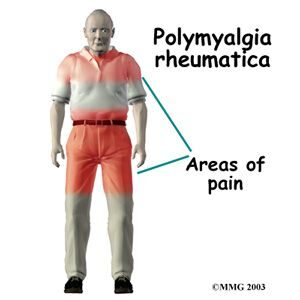Polymyalgia rheumatica
 Polymyalgia rheumatica is an inflammatory disorder that causes muscle pain and stiffness, primarily in your neck, shoulders, upper arms, hips and thighs. Symptoms of polymyalgia rheumatica usually begin quickly over a few days.
Polymyalgia rheumatica is an inflammatory disorder that causes muscle pain and stiffness, primarily in your neck, shoulders, upper arms, hips and thighs. Symptoms of polymyalgia rheumatica usually begin quickly over a few days.
Most people who develop polymyalgia rheumatica are older than 65, and it rarely affects people younger than 50.
Anti-inflammatory drugs called corticosteroids improve the symptoms of polymyalgia rheumatica, but these drugs require careful monitoring for serious side effects.
Polymyalgia rheumatica causes muscle pain and stiffness in your neck, shoulders and hips. It is most common in women and almost always occurs in people over 50. The main symptom of polymyalgia rheumatica is stiffness after resting. Other symptoms include fever, weakness and weight loss. In some cases, polymyalgia rheumatica develops overnight. In others, it is gradual.
Polymyalgia rheumatica sometimes occurs along with giant cell arteritis, a condition that causes swelling of the arteries in your head. Symptoms include headaches and blurred vision. Doctors often prescribe a medicine called prednisone for both conditions. Polymyalgia rheumatic usually responds to treatment. Without treatment, it usually goes away after a year or more. Untreated, giant cell arteritis carries a small risk of blindness or stroke.
Polymyalgia rheumatica is related to and may coexist with another inflammatory disorder called giant cell arteritis, which can cause headaches, visual impairment, jaw pain and other symptoms.
Symptoms
The signs and symptoms of polymyalgia rheumatica usually occur on both sides of the body and might include:
- Aches or pain in your shoulders
- Aches or pain in your neck, upper arms, buttocks, hips or thighs
- Stiffness in affected areas, particularly in the morning or after being inactive for a time
- Limited range of motion in affected areas
- Pain or stiffness in your wrists, elbows or knees
You might also have more-general signs and symptoms, including:
- Mild fever
- Fatigue
- A general feeling of not being well (malaise)
- Loss of appetite
- Unintended weight loss
- Depression
Causes
The exact cause of polymyalgia rheumatica is unknown. Two factors appear to be involved in the development of this condition:
- Certain genes and gene variations might increase your susceptibility.
- An environmental exposure.New cases of polymyalgia rheumatica tend to come in cycles, possibly developing seasonally. This suggests that an environmental trigger, such as a virus, might play a role. But no specific virus has been shown to cause polymyalgia rheumatica.
Giant cell arteritis
Polymyalgia rheumatica and another disease known as giant cell arteritis share many similarities. Many people who have one of these diseases also have symptoms of the other.
Giant cell arteritis results in inflammation in the lining of the arteries, most often the arteries in the temples. Signs and symptoms include headaches, jaw pain, vision problems and scalp tenderness. If left untreated, this condition can lead to stroke or blindness.
Treatment
At Alimran Medical Center, we may recommend any of the following treatments
Regenerative medicine treatment (Prolotherapy)
Neurons stimulation
Transcranial direct current stimulation (tDCS)
Steroid injection
- Trigger point injections
- Epidural steroid injections
- Electrical stimulation
- Short and long wave
- Laser therapy
- Ultrasonic therapy
- Magnatic therapy
- Exercises
Chiropractic
